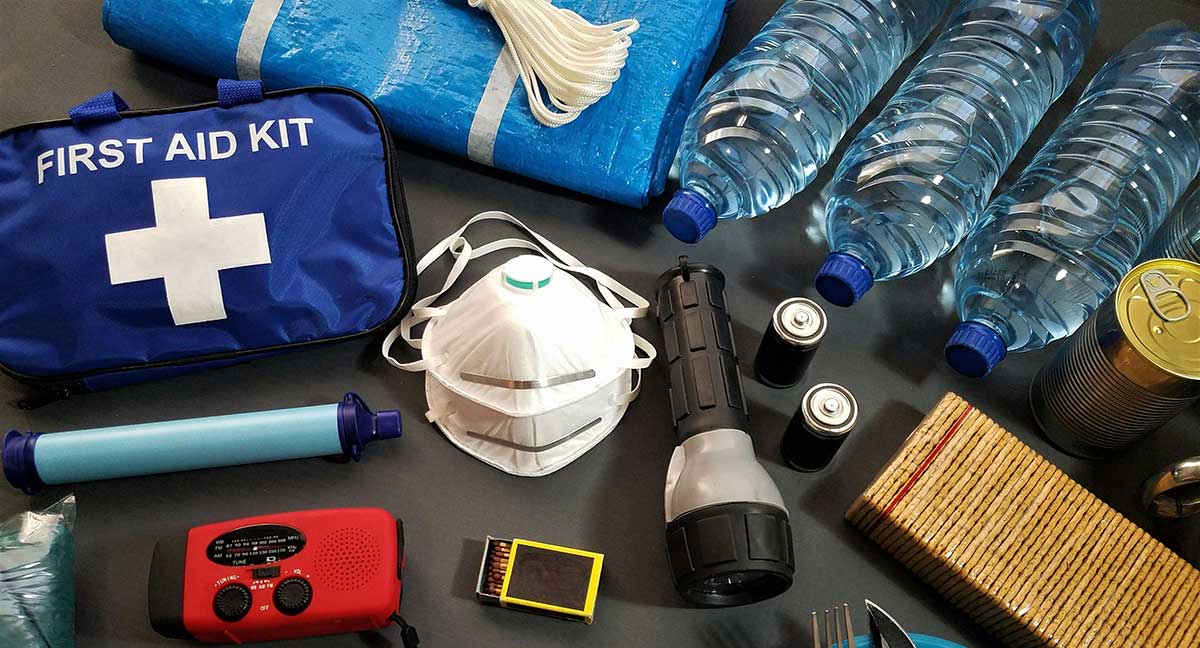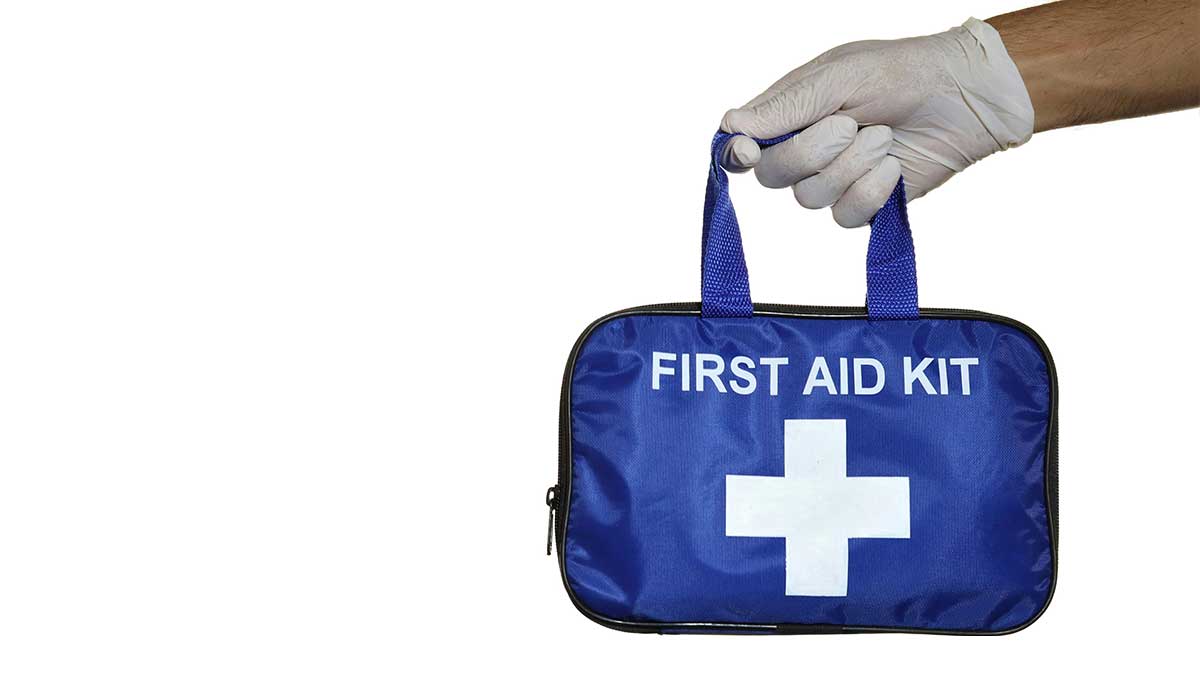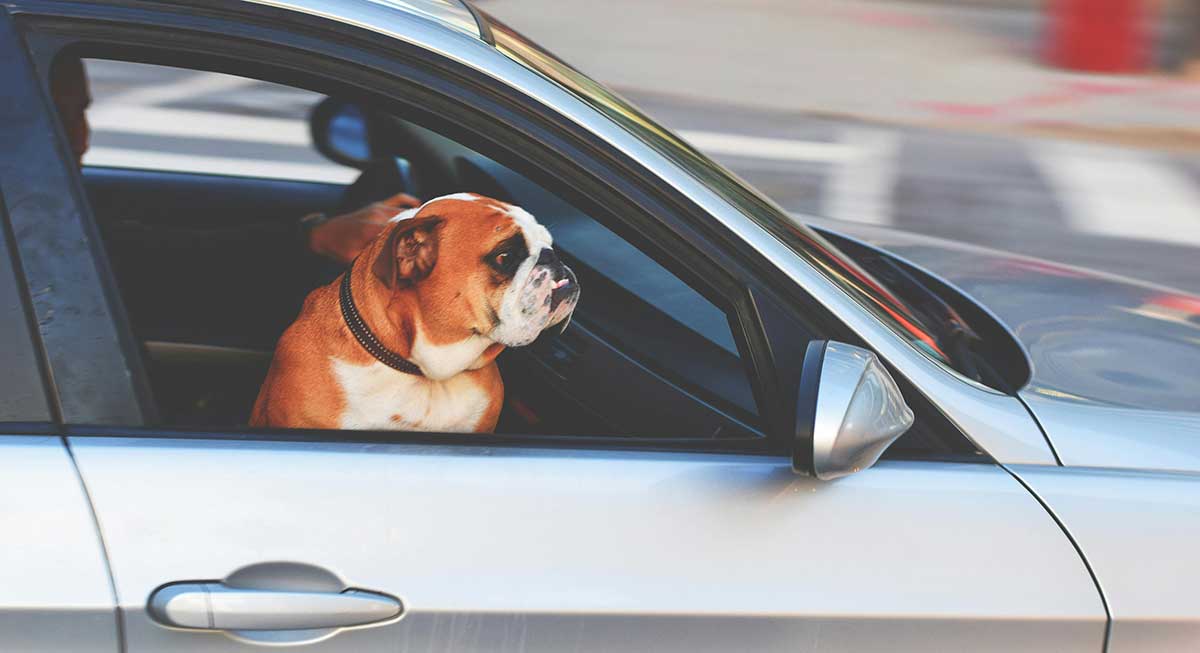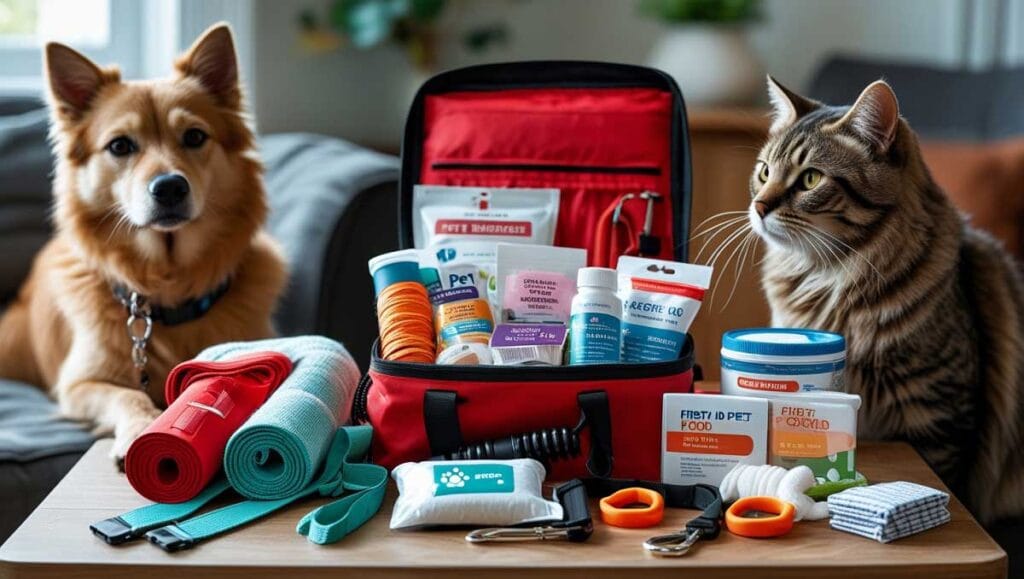When life’s little surprises occur, having a well-thought-out plan for your pets can make all the difference. As a responsible pet owner, you’re likely aware that emergencies can strike when least expected, and being prepared is vital. Do you know what essentials should be in your pet’s emergency kit or how to keep them calm during a crisis? Understanding local risks and having a clear, pet-inclusive evacuation plan can ease the stress of unexpected situations. Let’s explore the key steps that guarantee your furry friends are safe, come what may.
Be Prepared: Pet Safety in Emergencies
In any emergency, preparation is key, and guaranteeing your pet’s safety should be an integral part of your emergency plan.
Pet emergency preparedness involves creating a detailed strategy to protect your pets during disasters. Start by assembling an emergency kit containing your pet’s essentials: food, water, medications, and medical records. Include a sturdy leash or carrier to facilitate safe transport. Your kit should be easily accessible and regularly updated.
Develop an evacuation plan that includes pet-friendly shelters or accommodations. Identify local shelters or hotels that accept pets and keep a list of contacts handy. Regularly consult your veterinarian to make sure your pet’s vaccinations are current and discuss any specific emergency needs they may have.
In addition, microchip your pet and verify its registration details are up-to-date, as this greatly increases the chances of reunification if you become separated during a disaster.
Disaster preparedness isn’t just about having supplies; it requires a well-thought-out plan that prioritizes pet safety. Practicing these strategies can mitigate stress during an actual emergency, enhancing the likelihood of a positive outcome for both you and your pet.

Steps to Take Before an Emergency
To effectively prepare for emergencies, start by identifying the types of disasters common in your region.
Develop a thorough plan that includes assembling a pet disaster kit with essentials like food, water, and medications.
Regularly update this kit to guarantee all items remain within their expiration dates and are ready for immediate use.
Know Your Region’s Native Disasters
Understanding the specific types of natural disasters prevalent in your area is essential for effective pet emergency preparedness. Recognizing whether hurricanes, earthquakes, or wildfires are likely to occur in your region allows you to tailor your pet disaster preparedness plan effectively.
Each type of disaster presents unique challenges, and being aware of these can greatly enhance your readiness. For instance, if you live in a hurricane-prone area, anticipate the need for potential evacuation. This involves identifying pet-friendly shelters or accommodations in advance, ensuring you can transport your pet safely when disaster strikes.
In earthquake-prone regions, the unpredictability of these events means you should regularly practice emergency situations. Train your pets to respond to commands swiftly, which can be vital during chaotic moments.
Similarly, if wildfires are a common threat, prepare by maintaining a defensible space around your home and having a rapid evacuation plan that includes your pets.
Make a Plan
Creating a thorough emergency plan for your pets is critical to guaranteeing their safety during unexpected situations. Start by integrating them into your overall disaster plans. Identify evacuation routes and pet-friendly hotels in advance. You should always evacuate with your pets, as leaving them behind can jeopardize their safety.
Establish a ‘pet safe’ environment by knowing which local animal shelters can temporarily house them if necessary.
Develop a pet emergency preparedness kit that includes essentials such as food, water, medications, and identification documents. Having these supplies readily accessible will streamline the evacuation process.
Additionally, create a buddy system with a trusted neighbor who can assist in evacuating your pets if you’re not home during an emergency. This individual should be familiar with your pets and know where the emergency kit is stored.
Regularly review and practice your evacuation plan to guarantee efficiency and familiarity. This rehearsal enhances your ability to respond swiftly and effectively under stress.
Make a Disaster Kit for Pets
A well-prepared pet disaster kit is vital for guaranteeing the safety and well-being of your pets during emergencies. Begin by assembling an emergency kit for your pet that includes a pet first aid kit, which should contain bandages, antiseptic wipes, and any necessary medications.
It’s essential that your pet’s identification is up-to-date; make certain they’re microchipped and that all tags have current contact information.
Include carriers to transport pets safely, making sure they’re durable and well-ventilated, and that your pet is accustomed to using them. Stock your disaster kit with a minimum of three days’ worth of food and water per pet, stored in airtight containers to prevent spoilage.
Don’t forget to include feeding bowls and a manual can opener if necessary. Additionally, pack copies of your pet’s medical records and photographs for identification purposes. Comfort items, such as a favorite toy or blanket, can help reduce stress during a pet disaster.
Regularly check that all items in the kit are intact and functional. By preparing an emergency kit for your pet, you take an essential step in safeguarding their health and safety when unforeseen events occur.

Keep Your Pet Emergency Kit Up to Date
Preparation is the key to guaranteeing your pet emergency preparedness kit remains effective and ready for any situation. As a responsible pet owner, it’s vital to periodically review and update the contents of your emergency kit.
Start by checking the expiration dates on any first aid supplies, such as antiseptic wipes, bandages, and ointments. Replace expired items promptly to maintain the efficacy of your kit.
Next, verify your pet’s vaccination records and confirm they’re up to date. Keeping a copy of these records in your kit is essential for health and safety, particularly if you need to seek temporary shelter or veterinary care during a pet emergency.
Regularly inspect and rotate any perishable items, like the first aid supplies, to guarantee their freshness.
You should also include recent photographs of your pet in your kit, which can be invaluable if your pet becomes lost.
Food, Water, Medications
Meeting your pet’s fundamental needs for food, water, and medications during an emergency involves careful planning and foresight.
Begin by adding a sufficient supply of pet food to your emergency kit, ideally a two-week reserve. Opt for items with a long shelf life and rotate them every few months to maintain freshness.
It’s vital to include water—at least one gallon per pet per day—considering the potential for extended disruptions.
Incorporate any medications your pet requires, particularly if they’ve ongoing medical conditions. Prepare an inventory of these medications and consult your veterinarian in case you need specific storage instructions or alternatives.
A copy of your pet’s medical records, including vaccination history, should also be part of the items in your pet emergency preparedness kit.
If the need to evacuate arises, verify you can quickly gather your supplies and evacuate your animals efficiently.
This preparation will protect your pets and reduce stress during a pet emergency.
Pet First Aid Supplies
Building a robust pet first aid kit is vital to addressing emergencies swiftly and effectively. Start by assembling thorough pet first aid supplies tailored to your pet’s specific needs. A well-stocked cat or dog emergency kit should include items like antiseptic wipes, bandages, adhesive tape, and tweezers to manage minor injuries.
Add a digital thermometer to monitor your pet’s temperature, as well as hydrogen peroxide for inducing vomiting upon vet instruction. Sterile gloves and a muzzle or soft cloth can help manage your pet safely during treatment.
Incorporate a collar and harness with your pet’s name and number clearly visible, making sure they’re easily identifiable if separated. Your emergency plan should also account for basic survival: include bottled water, a collapsible bowl, and a few days’ worth of food.
Familiarize yourself with the kit’s contents and periodically check expiration dates to keep your pet safe. Having a detailed emergency plan that includes these pet first aid supplies greatly increases preparedness.
It’s important to keep your pet calm and secure during stressful situations. By preparing a thorough kit, you guarantee that your pets in an emergency receive the immediate care they need.

Pet Documentation for Emergencies
Taking proactive steps is essential when it comes to preparing pet documentation for emergencies. Start by compiling a thorough file for your cat or dog that includes vaccination records, medical history, and microchip information. These documents are critical, especially when boarding facilities or animal shelters need to accept pets during a disaster. Up-to-date vaccination records confirm your pet’s health status, facilitating smooth interactions with emergency services.
Consider creating a list of your pet’s dietary needs and any medications, including dosage instructions. This information guarantees that caregivers provide consistent care, even if you’re unable to do so. Include contact information for your veterinarian and a recent photo of your pet. A photo aids in identification if you become separated during an emergency.
Make sure that all documentation is easily accessible. Store physical copies in a waterproof, portable container and keep digital copies on a cloud service. This redundancy assures you’ll have access to essential information, regardless of the situation.
Before a disaster strikes, share these details with family members and trusted neighbors to strengthen your support network. With thorough documentation, you’ll be better prepared to make an evacuation plan, safeguarding your pet’s well-being.
Make a Pet Evacuation Plan and Practice Evacuating Your Pet
When it comes to preparing for emergencies, making a pet evacuation plan and practicing it can greatly increase your pet’s chances of staying safe.
Start by identifying pet-friendly shelters or hotels where you can board your pets, guaranteeing they’re not left behind. The Red Cross advises checking their guidelines as they often provide information on shelters that accommodate both pets and people.
It’s essential to confirm that service animals are included in your plan, as they’ve legal access to any facility.
Practice evacuating by conducting regular drills. Familiarize your pet with carriers or leashes and simulate the process of leaving home quickly. This can reduce stress for both you and your pet during real emergencies.
Keep a list of pet-friendly evacuation routes and emergency contacts handy, including friends or family willing to assist with temporary shelter.
In the chaos of an emergency, pets and people may become separated. Microchipping and identification tags are crucial for reuniting with your pet.
Always have recent photos of your pet in case they’re lost. By developing and practicing a detailed pet evacuation plan, you greatly enhance the likelihood of maintaining safety for both you and your pet.

Pet Emergency Kits for Cars
A well-prepared pet emergency kit for your car is vital for guaranteeing your pet’s safety during unexpected situations.
To start, you’ll want to include enough food and water for at least three days, tailored to your pet’s specific dietary needs. Consider collapsible bowls for easy storage.
Pack a first-aid kit equipped with bandages, antiseptic wipes, and any prescribed medications. This guarantees that if someone finds your pet, they can provide immediate care without delay.
Moreover, don’t waste time searching for identification. Keep copies of your pet’s medical records and recent photographs in a waterproof container. This not only aids in identification but also assists people and animals working in rescue operations.
A sturdy leash and harness are vital to maintain control and prevent your pet from fleeing in a panic. A blanket or towel can provide comfort and serve as a makeshift stretcher if needed.
Lastly, include a list of emergency contacts, such as your veterinarian and local animal shelters. This information guarantees you’re prepared and don’t leave your pets behind in an emergency.
Miscellaneous Pet Care Items
Before an emergency strikes, ensuring you have a thorough plan for your pet’s care is vital. Beyond the obvious necessities, there are miscellaneous items that can greatly impact your pet’s well-being during a crisis.
First, consider a sturdy, comfortable carrier or crate. This provides a secure environment and facilitates easy evacuation. Make sure your pet is accustomed to it beforehand to reduce stress.
Next, invest in a reflective collar and leash. These items enhance visibility, particularly in low-light conditions, which is essential during emergency evacuations. A properly fitted collar with an ID tag containing updated contact information is non-negotiable. Microchipping offers an additional layer of security, ensuring your pet can be identified if separated.
Include familiar toys and bedding in your emergency kit. These items offer comfort and can help alleviate anxiety in unfamiliar settings.
Additionally, collapsible food and water bowls are space-efficient and necessary for maintaining hydration and nutrition.

What to Do in an Emergency
In an emergency, guarantee you evacuate with your pet to minimize stress and potential harm.
If staying home is necessary, implement safety measures such as securing hazardous materials and designating a safe room.
For effective sheltering, whether evacuating or staying in place, maintain a pet emergency preparedness kit and establish a reliable tracking method to quickly locate your pet if they become lost.
If You Evacuate, Take Your Pet
When faced with an emergency evacuation, it’s imperative to include your pets in your plans to ascertain their safety and well-being. Ignoring this critical step can lead to distressing outcomes for both you and your pets.
Start by preparing a pet emergency kit. This kit should contain essentials like food, water, medications, vaccination records, and a first-aid kit tailored to your pet’s needs. Confirm you have a sturdy leash, harness, or carrier to keep them secure during transit.
Locate pet-friendly accommodations in advance. Many shelters and hotels have specific policies regarding pets, so verify these details beforehand. Have a list of nearby veterinary clinics and animal shelters as backup options, should your initial plans fall through.
Practice loading your pet in the car, securing them in a crate or with a pet seat belt to minimize stress during an actual evacuation.
Additionally, confirm your pet is microchipped and wears a collar with up-to-date identification tags. This step increases the likelihood of reunification if separation occurs.
If You Stay Home, Do it Safely
A fortified home can be your primary refuge during an emergency, but guaranteeing your pet’s safety requires diligent preparation and execution of a well-thought-out plan.
Begin by assembling an emergency kit for your pet, including food, water, medications, and copies of veterinary records. Store these supplies in a waterproof container and place it in an easily accessible location.
Familiarize yourself with your pet’s typical behavior to quickly detect stress or signs of distress during the emergency.
Create a safe space within your home, such as a windowless room, where your pet can stay secure and comfortable. Ascertain this area has adequate ventilation and is free from hazardous materials.
Secure heavy furniture and objects that could become projectiles. Maintain an emergency contact list, including your veterinarian and local animal shelters, so you can quickly reach out for assistance if needed.
Monitor weather alerts and news updates to stay informed about the situation. Remain calm and provide comfort to your pet, as animals can sense anxiety.
Consistently check emergency supplies and restock as necessary. By staying vigilant and prepared, you can guarantee a safer environment for both you and your pet during emergencies.
Sheltering During an Evacuation
Should circumstances necessitate evacuation, your pet’s safety hinges on meticulous planning and swift action. Start by identifying pet-friendly shelters or hotels in advance. This proactive measure guarantees you know exactly where to head, minimizing stress during an emergency. Confirm that these locations accept pets, as not all do, and have a list of alternatives.
Keep your pet’s emergency kit ready, including food, water, medications, and comfort items like toys or blankets.
During an evacuation, secure your pet in a sturdy carrier or harness. This containment reduces the risk of escape or injury. Attach identification tags to your pet with updated contact information, and consider microchipping as an additional safety measure.
Verify your pet’s vaccination records are current, as shelters may require proof.
Upon arrival at the shelter, adhere strictly to their guidelines to maintain order and safety. Familiarize yourself with the shelter’s layout and designated pet areas.
Monitor your pet’s behavior closely, as stress can manifest in atypical ways. Engage with shelter staff for any concerns, guaranteeing your pet’s needs are met. Your preparation today is essential for their protection tomorrow.

Sheltering in Place
In an emergency requiring you to shelter in place, start by gathering your pets and securing them in a safe, interior room away from windows and external doors.
Choose a space that offers protection and minimizes exposure to potential hazards. Verify the room is free from sharp objects and harmful substances. Once your pets are safe, create a comfortable environment by laying down blankets or pet beds.
Prepare an emergency kit with essentials: food, water, medications, and identification tags. Keep at least a three-day supply of food and water for each pet. Store medications in original containers, along with dosage instructions. Confirm all pets have collars with ID tags.
Maintain a calm demeanor to reduce stress for both you and your pets. Animals often pick up on your emotions, so staying composed is essential. Engage them with toys or gentle interaction to distract from the situation outside.
Guarantee ventilation in the chosen room while avoiding external air sources if the emergency involves airborne hazards.
Monitoring local news or emergency alerts using a battery-powered radio or smartphone is critical for updates. This preparation guarantees you and your pets remain safe and informed during emergencies.
Finding a Lost Pet
While keeping your pets safe during an emergency is paramount, sometimes unforeseen circumstances might lead to a pet becoming lost. Swift action is essential. First, search your immediate area thoroughly. Pets often hide nearby, so check under furniture, in closets, and in any small spaces they might squeeze into.
Remember, frightened animals may not respond to calls, so a quiet, methodical search is key.
Next, alert your neighbors. Provide them with a recent photo and your contact details. Utilize social media platforms and local community groups to broaden your search. Time is of the essence, so digital communication can expedite a wider reach.
Don’t forget to contact local animal shelters and veterinary clinics. Lost pets are frequently brought to these locations. Provide them with a detailed description of your pet, including any microchip information.
If your pet is microchipped, inform the microchip company as well; they can assist in spreading the word.
Consider creating and distributing flyers in your neighborhood. Clear, recent photos and contact information enhance the chances of recovery.
Persistence and a calm, organized approach are vital in maximizing the likelihood of reuniting with your lost pet.
Help Pets Recover After an Emergency
After an emergency, guaranteeing your pet’s recovery is essential for their well-being. First, assess your pet for physical injuries, checking for cuts, bruising, or limping. Gently examine their body, looking for signs of pain or discomfort, such as vocalization or withdrawal. If you suspect any injuries, contact your veterinarian immediately for guidance on appropriate care.
Monitoring your pet’s behavior is critical. Stress responses such as excessive panting, pacing, or hiding can indicate trauma. Maintain a calm environment to help them feel secure, reducing sudden noises and bright lights. Engage in gentle, familiar routines to provide comfort and stability. If behavioral changes persist, consult a veterinarian or a pet behaviorist.
Nutrition and hydration are key to recovery. Offer small, frequent meals of their regular diet, guaranteeing they’ve constant access to clean water. Dehydration can be a significant risk, so monitor their intake closely.
Lastly, provide a quiet, comfortable space for rest. Recovery requires ample sleep, so guarantee their bedding is clean and supportive.

How to Keep Yourself and Your Pets Healthy During a Disaster
Effective disaster preparedness is vital for maintaining the health of both you and your pets. Begin by assembling an emergency kit that includes food, water, medications, and first-aid supplies for your pets. Make certain that this kit is easily accessible and regularly updated.
During a disaster, it’s essential to maintain hygiene to prevent infections. Use hand sanitizers if water is scarce and keep your pets’ living areas clean.
Monitor your pets for signs of stress, such as changes in eating habits or excessive grooming. Stress can weaken their immune systems, making them more susceptible to illness. Provide a safe, quiet space where they can retreat and feel secure. If possible, maintain their routine to offer a sense of normalcy.
In terms of nutrition, guarantee your pets have access to clean food and water. Contaminated resources can lead to gastrointestinal issues. Store food in airtight containers and use bottled water if necessary.
Lastly, keep a close watch on local health advisories. Some disasters may increase the risk of exposure to environmental hazards. Staying informed allows you to make quick, educated decisions to protect both your and your pets’ health effectively.
Diseases That Can Spread Between Pets and People During a Natural Disaster
Natural disasters can create conditions that increase the risk of zoonotic diseases—those that spread between pets and humans. When floods, hurricanes, or earthquakes disrupt normal living conditions, they can lead to sanitation breakdowns, overcrowding, and increased contact between humans and animals. These factors elevate the transmission risk of diseases like leptospirosis, rabies, and toxoplasmosis.
Leptospirosis, a bacterial disease, thrives in water contaminated by animal urine. During floods, you should prevent your pets from wading in standing water.
Rabies, a viral disease, can spread through the saliva of infected animals. Make sure your pets’ vaccinations are up to date to reduce this risk.
Toxoplasmosis, caused by a parasite commonly found in cat feces, can result in severe health issues for pregnant women and immunocompromised individuals. Maintain hygiene by using gloves and washing hands after handling litter.
In emergencies, it’s essential to minimize direct contact with wildlife or unfamiliar animals. Use barriers such as leashes and carriers to maintain distance.
Tips for Handling Injured Pets
Caring for an injured pet during an emergency requires calmness and swift action. First, evaluate the situation to verify both your safety and your pet’s. Approach them slowly to prevent further stress or injury.
If your pet is bleeding, apply direct pressure with a clean cloth or gauze to control hemorrhage. Avoid using tourniquets unless absolutely necessary, as they can cause additional harm.
For fractures, minimize movement by gently immobilizing the affected area with a splint made from rolled-up newspapers or cardboard. Avoid setting the fracture yourself, as incorrect alignment can worsen the injury.
In cases of difficulty breathing, clear any visible obstructions in their mouth and gently extend their neck to open the airway. Be cautious, as injured pets may bite due to pain.
Transport your pet to a veterinarian as soon as possible. While moving them, keep them warm and secure to limit movement. Utilize a pet carrier or a sturdy box with ventilation, if available.
Always remain observant for signs of shock, such as pale gums, rapid breathing, or a weak pulse, and communicate these symptoms to the veterinarian immediately upon arrival.
Conclusion
In the chaos of a natural disaster, being unprepared is like playing with fire. To guarantee your pet’s safety, assemble a thorough emergency kit and regularly update it. Familiarize your pets with evacuation procedures and understand local disaster risks. Have a clear evacuation plan, including pet-friendly accommodations. Post-disaster, prioritize your pet’s health and watch for diseases. By taking these steps, you guarantee that both you and your pets can navigate emergencies with minimal stress.

